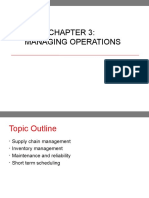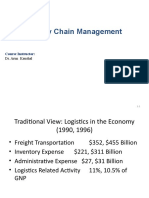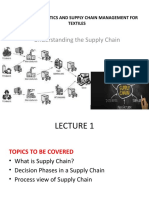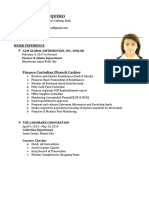0 ratings0% found this document useful (0 votes)
85 viewsSCM1
SCM1
Uploaded by
hasib_ahsanscm
Copyright:
© All Rights Reserved
Available Formats
Download as PPT, PDF, TXT or read online from Scribd
SCM1
SCM1
Uploaded by
hasib_ahsan0 ratings0% found this document useful (0 votes)
85 views37 pagesscm
Copyright
© © All Rights Reserved
Available Formats
PPT, PDF, TXT or read online from Scribd
Share this document
Did you find this document useful?
Is this content inappropriate?
scm
Copyright:
© All Rights Reserved
Available Formats
Download as PPT, PDF, TXT or read online from Scribd
Download as ppt, pdf, or txt
0 ratings0% found this document useful (0 votes)
85 views37 pagesSCM1
SCM1
Uploaded by
hasib_ahsanscm
Copyright:
© All Rights Reserved
Available Formats
Download as PPT, PDF, TXT or read online from Scribd
Download as ppt, pdf, or txt
You are on page 1of 37
2004 Prentice-Hall, Inc.
Supply Chain Management
Chapter 1
Understanding the Supply Chain
2004 Prentice-Hall, Inc. 1-2
Outline
What is a Supply Chain?
Decision Phases in a Supply Chain
Process View of a Supply Chain
The Importance of Supply Chain Flows
Examples of Supply Chains
2004 Prentice-Hall, Inc.
What is Supply Chain?
A supply chain consists of all parties involved directly
or indirectly, in fulfilling a customer request.
The supply chain includes not only the manufacturer
and supplier but also transporters, warehouses,
retailers and even customers themselves.
Within each organization the supply chain includes all
functions involved in receiving and filling a customer
request.
1-3
2004 Prentice-Hall, Inc.
What is Supply Chain?
Martin Christopher, Emeritus Professor of Marketing and
Logistics at Cranfield School of Management, suggests
that the supply chain is the network of organizations that
are involved, through upstream (supplier end of the
supply chain) and downstream (customer end of the
supply chain) linkages, in the different processes and
activities that produce value in the form of products and
services in the hands of the ultimate consumer.
1-4
2004 Prentice-Hall, Inc.
Vertical Integration Vs Supply
Chain
Vertical integration implies ownership or at least
control of upstream suppliers and downstream
entities, whereas SCM does not necessarily imply any
such ownership or control of supply chain partners.
1-5
2004 Prentice-Hall, Inc. 1-6
What is a Supply Chain?
All stages involved, directly or indirectly, in fulfilling a
customer request
Suppliers,
manufacturers,
wholesalers/distributers,
retailers,
Customers
as well as transporters.
Examples: Wal-Mart, Dell
2004 Prentice-Hall, Inc. 1-7
Supply Chain
Supplier Manufacturer
Wholesaler/
Distributer
Retailer Customer
I nformation
Product
Funds
2004 Prentice-Hall, Inc. 1-8
What is a Supply Chain?
Customer is an integral part of the supply chain
Includes movement of information, funds, and
products in both directions
Probably more accurate to use the term supply
network or supply web
All stages may not be present in all supply chains
(e.g., no retailer or distributor for Dell)
2004 Prentice-Hall, Inc. 1-9
Stages of Detergent Supply Chain
Customer wants
detergent and goes
to Wall Mart
Wall Mart
Supermarket
Wall Mart or
Third party DC
P&G or other
manufacturer
Plastic
Producer
Chemical
manufacturer
(e.g. Oil Company)
Tenneco
Packaging
Paper
Manufacturer
Timber
Industry
Chemical
manufacturer
(e.g. Oil Company)
2004 Prentice-Hall, Inc.
Supply chain management
Supply chain management is the management of
flows between and among supply chain stages to
maximize total supply chain profitability.
Or
Supply chain management (SCM) is the management
across a network of upstream and downstream
organizations of material, information and resource
flows that lead to the creation of value in the form of
products and/or services.
1-10
2004 Prentice-Hall, Inc. 1-11
The Objective of a Supply Chain
Maximize overall value created by the SC.
Supply chain value=
worth of the final product to the customer
- supply chain costs of in filling the customers request
Value is correlated to supply chain profitability (difference
between revenue generated from the customer and the overall
cost across the supply chain)
2004 Prentice-Hall, Inc. 1-12
The Objective of a Supply Chain
Example: Dell receives $2000 from a customer for a computer
(revenue)
Supply chain incurs costs (information, storage, transportation,
components, assembly, etc.)
Difference between $2000 and the sum of all of these costs is
the supply chain profit.
Supply chain profitability is total profit to be shared across all
stages of the supply chain
Supply chain success should be measured by total supply chain
profitability, not profits at an individual stage!
2004 Prentice-Hall, Inc. 1-13
The Objective of a Supply Chain
Sources of supply chain revenue: the customer
Sources of supply chain cost: flows of information,
products, or funds between stages of the supply chain
2004 Prentice-Hall, Inc. 1-14
Decision Phases of a Supply Chain
Supply chain strategy or design
Supply chain planning
Supply chain operation
2004 Prentice-Hall, Inc. 1-15
Supply Chain Strategy or Design
Decisions about the structure of the supply chain and what
processes each stage will perform over the next several years.
Strategic supply chain decisions
Locations and capacities of facilities
Products to be made or stored at various locations
Modes of transportation
Information systems
Supply chain design must support strategic objectives
Supply chain design decisions are long-term and expensive to
reverse must take into account market uncertainty
2004 Prentice-Hall, Inc. 1-16
Supply Chain Planning
Definition of a set of policies that govern short-term
operations
Fixed by the supply configuration from previous
phase
Starts with a forecast of demand in the coming year
Usually time horizon is the quarter of a year.
2004 Prentice-Hall, Inc. 1-17
Supply Chain Planning
Planning decisions:
Which markets will be supplied from which locations
Planned buildup of inventories
Subcontracting, backup locations
Inventory policies
Timing and size of market promotions
Must consider in planning decisions demand
uncertainty, exchange rates, competition over the time
horizon
2004 Prentice-Hall, Inc. 1-18
Supply Chain Operation
Time horizon is weekly or daily.
Decisions regarding individual customer orders
Allocate orders to inventory or production, set order due
dates, generate pick lists at a warehouse, allocate an order to
a particular shipment, set delivery schedules, place
replenishment orders
Supply chain configuration is fixed and operating
policies are determined
Goal is to implement the operating policies as
effectively as possible
Much less uncertainty (short time horizon)
2004 Prentice-Hall, Inc.
The goal is to handle incoming customer order in the
best possible manner.
During this Phase
-Firms allocate inventory or production to individual orders
-Set a date that an order is to be filled
-Generate pick list at a warehouse
-Allocate an order to particular shipping mode and shipment
-Set delivery schedules of trucks and
-Place replenishment orders
1-19
Supply Chain Operation
2004 Prentice-Hall, Inc. 1-20
Process View of a Supply Chain
Cycle view: processes in a supply chain are divided
into a series of cycles, each performed at the
interfaces between two successive supply chain stages
Push/pull view: processes in a supply chain are
divided into two categories depending on whether
they are executed in response to a customer order
(pull) or in anticipation of a customer order (push)
2004 Prentice-Hall, Inc. 1-21
Cycle View of Supply Chains
Customer Order Cycle
Replenishment Cycle
Manufacturing Cycle
Procurement Cycle
Customer
Retailer
Distributor
Manufacturer
Supplier
2004 Prentice-Hall, Inc.
Sub-processes in each
Supply Chain
1-22
Supplier Stage
Markets Product
Buyer Stage
Places Order
Supplier Stage
Receives Order
Buyer returns reverse
flow to supplier or third
party
Buyer Stage
Receives Order
Supplier Stage
Supplies Order
2004 Prentice-Hall, Inc. 1-23
Cycle View of a Supply Chain
Each cycle occurs at the interface between two
successive stages
Customer order cycle (customer-retailer)
Replenishment cycle (retailer-distributor)
Manufacturing cycle (distributor-manufacturer)
Procurement cycle (manufacturer-supplier)
Cycle view clearly defines processes involved and
the owners of each process. Specifies the roles
and responsibilities of each member and the
desired outcome of each process.
2004 Prentice-Hall, Inc. 1-24
Customer Order Cycle
Involves all processes directly involved in receiving
and filling the customers order
Customer arrival
Customer order entry
Customer order fulfillment
Customer order receiving
2004 Prentice-Hall, Inc. 1-25
Replenishment Cycle
All processes involved in replenishing retailer
inventories (retailer is now the customer)
Retail order trigger
Retail order entry
Retail order fulfillment
Retail order receiving
2004 Prentice-Hall, Inc. 1-26
Manufacturing Cycle
All processes involved in replenishing distributor (or
retailer) inventory
Order arrival from the distributor, retailer, or customer
Production scheduling
Manufacturing and shipping
Receiving at the distributor, retailer, or customer
2004 Prentice-Hall, Inc. 1-27
Procurement Cycle
All processes necessary to ensure that materials are
available for manufacturing to occur according to
schedule
Manufacturer orders components from suppliers to
replenish component inventories
However, component orders can be determined
precisely from production schedules (different from
retailer/distributor orders that are based on uncertain
customer demand)
Important that suppliers be linked to the manufacturers
production schedule
2004 Prentice-Hall, Inc. 1-28
Push/Pull View of Supply Chains
Procurement,
Manufacturing and
Replenishment cycles
Customer Order
Cycle
Customer
Order Arrives
PUSH PROCESSES PULL PROCESSES
2004 Prentice-Hall, Inc. 1-29
Push/Pull View of
Supply Chain Processes
Supply chain processes fall into one of two categories
depending on the timing of their execution relative to
customer demand
Pull: execution is initiated in response to a customer
order (reactive). Also called make-to-order
Push: execution is initiated in anticipation of customer
orders (speculative). Also called make-to-stock
Push/pull boundary separates push processes from
pull processes
2004 Prentice-Hall, Inc. 1-30
Push/Pull View of
Supply Chain Processes
Useful in considering strategic decisions relating to
supply chain design more global view of how
supply chain processes relate to customer orders
Can combine the push/pull and cycle views
L.L. Bean
Dell
The relative proportion of push and pull processes can
have an impact on supply chain performance
2004 Prentice-Hall, Inc. 1-31
Ex: L.L. Bean, a mail order company
Customer Order Cycle
Replenishment and
Manufacturing Cycle
Procurement Cycle
Customer
L.L.Bean
Manufacturer
Supplier
Customer order
arrives
PULL PROCESSES
PUSH PROCESSES
2004 Prentice-Hall, Inc. 1-32
Ex: Dell Computers
Customer Order and
Manufacturing Cycle
Procurement Cycle
Customer
Manufacturer
Supplier
Customer order
arrives
PULL PROCESSES
PUSH PROCESSES
2004 Prentice-Hall, Inc. 1-33
Supply Chain Macro Processes
All SC processes can be classified into three categories.
SRM
Supplier Relationship
Management
ISCM
Internal Supply Chain
Management
CRM
Customer Relationship
Management
Supplier
Firm
Customer
Source
Negotiate
Buy
Design
Collaboration
Supply
Collaboration
Strategic Planning
Demand Planning
Supply Planning
Fulfillment
Field Service
Market
Sell
Call Center
Order Management
2004 Prentice-Hall, Inc. 1-34
The Importance of Supply
Chain Flows
Supply chain decisions can play a significant role in
the success or failure of a firm
Close connection between design and management of
supply chain flows (product, information and cash)
and supply chain success
Ex:
Dell invested in managing the flows effieiciently: success
Quaker Oats purchased Snapple: failure
2004 Prentice-Hall, Inc. 1-35
Examples of Supply Chains:
7-Eleven Japan
What factors influence decisions of opening and closing stores?
Location of stores?
Why has 7-Eleven chosen off-site preparation of fresh food?
Why does 7-Eleven discourage direct store delivery from vendors?
Where are distribution centers located and how many stores does
each center serve? How are stores assigned to distribution centers?
Why does 7-Eleven combine fresh food shipments by temperature?
What point of sale data does 7-Eleven gather and what information
is made available to store managers? How should information
systems be structured?
2004 Prentice-Hall, Inc. 1-36
Summary of Learning Objectives
What are the cycle and push/pull views of a supply
chain?
How can supply chain macro processes be classified?
What are the three key supply chain decision phases
and what is the significance of each?
What is the goal of a supply chain and what is the
impact of supply chain decisions on the success of the
firm?
2004 Prentice-Hall, Inc. 1-37
Amazon.com
Why is Amazon building more warehouses as it grows? How
many warehouses should it have and where should they be
located?
What advantages does selling books via the Internet provide? Are
there disadvantages?
Why does Amazon stock bestsellers while buying other titles
from distributors?
Does an Internet channel provide greater value to a bookseller like
Borders or to an Internet-only company like Amazon?
Should traditional booksellers like Borders integrate e-commerce
into their current supply?
For what products does the e-commerce channel offer the greatest
benefits? What characterizes these products?
You might also like
- Procurement Audit PlanDocument12 pagesProcurement Audit PlanMustafa Bilal100% (2)
- Marketing Scales HandbookDocument27 pagesMarketing Scales Handbookhasib_ahsanNo ratings yet
- Logistics and Supply Chain Management: Dr. R. S. GhoshDocument164 pagesLogistics and Supply Chain Management: Dr. R. S. Ghoshamitrao1983No ratings yet
- HRM: People Manager Coursera Milestone Week 4Document5 pagesHRM: People Manager Coursera Milestone Week 4Charmis TubilNo ratings yet
- Lecture1515 - 26553 - Lecture 15 Supply Chain Management BasicsDocument51 pagesLecture1515 - 26553 - Lecture 15 Supply Chain Management BasicsAman kumar singhNo ratings yet
- Supply ChainDocument35 pagesSupply ChainRayhan Atunu0% (1)
- DR - Debmalya Ghosh: © 2007 Pearson Education 1-1Document23 pagesDR - Debmalya Ghosh: © 2007 Pearson Education 1-1Ruchi KumariNo ratings yet
- SCM 1Document25 pagesSCM 1Gaurav YadavNo ratings yet
- Understanding The Supply ChainDocument33 pagesUnderstanding The Supply ChainZain ZulfiqarNo ratings yet
- SCM 01 IntroDocument24 pagesSCM 01 IntroVishesh khandelwalNo ratings yet
- Week 1-Intro To GSCMDocument34 pagesWeek 1-Intro To GSCMAkhmad YunaniNo ratings yet
- Chopra Scm5 Ch01Document27 pagesChopra Scm5 Ch01Zohaib AhsonNo ratings yet
- Chapter 1 - SCMDocument27 pagesChapter 1 - SCMAmelia SoniaNo ratings yet
- Note Pdtmog - Operations Management Chapter 3Document25 pagesNote Pdtmog - Operations Management Chapter 3muneergaming jaibNo ratings yet
- Managing The Supply ChainDocument23 pagesManaging The Supply Chainerony92No ratings yet
- Unit1 SCMDocument33 pagesUnit1 SCMAdwait DumbreNo ratings yet
- Chapter 1Document33 pagesChapter 1projects_masterz100% (1)
- Introduction To SCMDocument33 pagesIntroduction To SCMRISHIKA SINHANo ratings yet
- CH 1 Understanding The Supply ChainDocument37 pagesCH 1 Understanding The Supply ChainAmina KhawajaNo ratings yet
- Chopra 03 ChapterDocument56 pagesChopra 03 ChapterRashadafanehNo ratings yet
- Unit 3-Introduction of SCMDocument37 pagesUnit 3-Introduction of SCMeskpg066No ratings yet
- SCM - CH1 Understanding SCDocument38 pagesSCM - CH1 Understanding SCMrunal ShethNo ratings yet
- The Objective of A Supply ChainDocument24 pagesThe Objective of A Supply ChainNayaz UddinNo ratings yet
- Chopra3 PPT ch01Document39 pagesChopra3 PPT ch01Rachel Hasibuan100% (1)
- Introduction SCMDocument41 pagesIntroduction SCMsakhawatNo ratings yet
- SCM1Document48 pagesSCM1partha080No ratings yet
- Introduction To Supply Chain ManagementDocument37 pagesIntroduction To Supply Chain ManagementPradeep Biradar100% (1)
- KUL 1 Chopra INTRO Sept2011Document48 pagesKUL 1 Chopra INTRO Sept2011Uge HolicNo ratings yet
- Introduction To Supply Chain Management: Mcgraw-Hill/IrwinDocument60 pagesIntroduction To Supply Chain Management: Mcgraw-Hill/Irwintariq_jamil99No ratings yet
- Chopra Scm5 Ch06Document32 pagesChopra Scm5 Ch06nomanashrafNo ratings yet
- MGMT 655: Chapter 1 Understanding The Supply Chain: Prof. Willem SelenDocument38 pagesMGMT 655: Chapter 1 Understanding The Supply Chain: Prof. Willem SelenAhmedNo ratings yet
- Building Strategic Framework To Analyze Supply Chains: 1.1. Understanding The Supply ChainDocument42 pagesBuilding Strategic Framework To Analyze Supply Chains: 1.1. Understanding The Supply ChainPrakash TirumaniNo ratings yet
- Understanding Supply Chain MCQSDocument7 pagesUnderstanding Supply Chain MCQSJustice OwusuNo ratings yet
- Supply Chain ManagementDocument27 pagesSupply Chain ManagementParth Kapoor100% (1)
- MENG148 - Module 1Document21 pagesMENG148 - Module 1Reimon DoblonNo ratings yet
- Understanding The Supply ChainDocument34 pagesUnderstanding The Supply ChainNauryzbek MukhanovNo ratings yet
- Understanding The Supply ChainDocument32 pagesUnderstanding The Supply ChainGuarantee International CollegeNo ratings yet
- Logistics and Supply ChainDocument8 pagesLogistics and Supply ChainManikandan SuriyanarayananNo ratings yet
- Log SCM Lec 2Document23 pagesLog SCM Lec 2ahmed.saber0684No ratings yet
- Push Pull Boundary SCMDocument40 pagesPush Pull Boundary SCMniteshaptNo ratings yet
- SCLMDocument6 pagesSCLMPraveen HansNo ratings yet
- Chapter 1Document25 pagesChapter 1Ankita SinghNo ratings yet
- SCM Chapter 1Document8 pagesSCM Chapter 1olmezestNo ratings yet
- Supply Chain Managment MR TKDocument43 pagesSupply Chain Managment MR TKsonal kumari shrivasNo ratings yet
- Supply Chain ManagementDocument30 pagesSupply Chain ManagementRahul VermaNo ratings yet
- Global Supply Chain Management Notes-Msc Procurement and Logistics-Sept, 2023Document85 pagesGlobal Supply Chain Management Notes-Msc Procurement and Logistics-Sept, 2023hassan28sepNo ratings yet
- Supply Chain Optimization - Jose PintoDocument199 pagesSupply Chain Optimization - Jose Pintomanujosephv8752No ratings yet
- PPP SCM Chapter1 (Supply Chain Management)Document29 pagesPPP SCM Chapter1 (Supply Chain Management)Mahfuz Raihan100% (1)
- CH - 01 (Understanding Supply Chain Management)Document37 pagesCH - 01 (Understanding Supply Chain Management)Abdullah KafiNo ratings yet
- SC Strategy1 MidDocument14 pagesSC Strategy1 MidaliNo ratings yet
- Chopra Scm5 Ch01 GeDocument31 pagesChopra Scm5 Ch01 Geফয়সাল হোসেন100% (1)
- Introduction To Supply Chain ManagementDocument45 pagesIntroduction To Supply Chain ManagementAsha ChikkaputtegowdaNo ratings yet
- SCM G Students Handout Solutions - SP5 - 2013Document25 pagesSCM G Students Handout Solutions - SP5 - 2013lordraiNo ratings yet
- SCM Module 1Document37 pagesSCM Module 1Mostakim Ahmad ShairNo ratings yet
- Module1scm 150216091253 Conversion Gate01Document94 pagesModule1scm 150216091253 Conversion Gate01sathya priyaNo ratings yet
- Supply ChainDocument5 pagesSupply ChainMd. Parvej HossainNo ratings yet
- Understanding The Supply ChainDocument33 pagesUnderstanding The Supply ChainkanjanaNo ratings yet
- Supply Chain ManagementDocument3 pagesSupply Chain ManagementpushkarNo ratings yet
- Understanding SC (1)Document32 pagesUnderstanding SC (1)Suddapally VIVEK ReddyNo ratings yet
- Military Supply Chain Management: From Deployment to Victory, Mastering the Logistics DanceFrom EverandMilitary Supply Chain Management: From Deployment to Victory, Mastering the Logistics DanceNo ratings yet
- Logistics in Manufacturing, Supply Chain, and Distribution: The Supply Chain Journey, #1From EverandLogistics in Manufacturing, Supply Chain, and Distribution: The Supply Chain Journey, #1No ratings yet
- Optimal Control and Optimization of Stochastic Supply Chain SystemsFrom EverandOptimal Control and Optimization of Stochastic Supply Chain SystemsNo ratings yet
- Bank ManagementDocument4 pagesBank Managementhasib_ahsanNo ratings yet
- Chapter 5 Advertising Management CampaignDocument43 pagesChapter 5 Advertising Management Campaignhasib_ahsan100% (1)
- Business EnvironmentDocument16 pagesBusiness Environmenthasib_ahsan50% (2)
- Introduction To Business: Course Code: BUSI-1101Document36 pagesIntroduction To Business: Course Code: BUSI-1101hasib_ahsanNo ratings yet
- SyllabusDocument2 pagesSyllabushasib_ahsanNo ratings yet
- A Measure of Retail Service Quality: KeywordsDocument9 pagesA Measure of Retail Service Quality: Keywordshasib_ahsanNo ratings yet
- Evolution of BusinessDocument4 pagesEvolution of Businesshasib_ahsanNo ratings yet
- Introduction To Business: Course Code: BUSI-1101Document8 pagesIntroduction To Business: Course Code: BUSI-1101hasib_ahsan0% (1)
- Example: $1.5 Per Direct Labor DollarDocument1 pageExample: $1.5 Per Direct Labor Dollarhasib_ahsanNo ratings yet
- Advanced Chemical Industries Limited: HistoryDocument1 pageAdvanced Chemical Industries Limited: Historyhasib_ahsanNo ratings yet
- HR Practices in Insurance Companies: A Case Study of BangladeshDocument14 pagesHR Practices in Insurance Companies: A Case Study of Bangladeshhasib_ahsanNo ratings yet
- Designing and Managing Integrated Marketing Channels: Key ConceptsDocument30 pagesDesigning and Managing Integrated Marketing Channels: Key Conceptshasib_ahsanNo ratings yet
- ACI Performance ManagementDocument23 pagesACI Performance Managementhasib_ahsanNo ratings yet
- SCM2Document31 pagesSCM2hasib_ahsanNo ratings yet
- MCQ Bank Ch1 Pom KotlerDocument5 pagesMCQ Bank Ch1 Pom Kotlerhasib_ahsan100% (1)
- Ebook Schemes Ministry of Jal Shakti Lyst8874Document7 pagesEbook Schemes Ministry of Jal Shakti Lyst8874exp expoNo ratings yet
- Allocation of Resources in The PhilippinesDocument3 pagesAllocation of Resources in The PhilippinesAngelNo ratings yet
- ACF - Boston BeerDocument42 pagesACF - Boston BeerpermafrostXx89% (9)
- Income Taxation PDFDocument7 pagesIncome Taxation PDFSoahNo ratings yet
- Forecasting Exchange RatesDocument21 pagesForecasting Exchange RatesmernaNo ratings yet
- Pertemuan #10 Andri Budiwidodo, S.Si., M.IkomDocument38 pagesPertemuan #10 Andri Budiwidodo, S.Si., M.IkomK60 NGUYỄN XUÂN HOANo ratings yet
- Chrisselyn QuinqueroDocument4 pagesChrisselyn QuinqueroChrizeaNo ratings yet
- Tetra Pak Group - Sustainability Update Report 2014 PDFDocument74 pagesTetra Pak Group - Sustainability Update Report 2014 PDFCSRMedia NetworkNo ratings yet
- Land and BuildingDocument4 pagesLand and BuildingHannah OrosNo ratings yet
- Poster Webinar SST 2024Document3 pagesPoster Webinar SST 2024Berry LauNo ratings yet
- Carpio Vs Modair Manila Co. LTD., Inc.Document25 pagesCarpio Vs Modair Manila Co. LTD., Inc.Rudnar Jay Bañares BarbaraNo ratings yet
- Hyderabad Electric Supply Company - Electricity Consumer Bill (Mdi)Document20 pagesHyderabad Electric Supply Company - Electricity Consumer Bill (Mdi)Engineer WaseemNo ratings yet
- A Study On The Impact of The COVID-19 Crisis On The Indian Micro, Small and Medium EnterprisesDocument56 pagesA Study On The Impact of The COVID-19 Crisis On The Indian Micro, Small and Medium EnterprisesMansiNo ratings yet
- de Soto - The Challenge of Connecting Informal and Formal Property Systems Some Reflections Based On The Case of TanzaniaDocument41 pagesde Soto - The Challenge of Connecting Informal and Formal Property Systems Some Reflections Based On The Case of TanzanialahoozNo ratings yet
- Yesbank Debit Card Complimentary LoungeDocument2 pagesYesbank Debit Card Complimentary LoungetwinklealwishNo ratings yet
- Earliest Forms of BankingDocument25 pagesEarliest Forms of BankingMohd Anwar KhanNo ratings yet
- A Brand New Relative Strength IndexDocument8 pagesA Brand New Relative Strength IndexJuna NaelgaNo ratings yet
- Why Entreprenuership Has Won-Howard StevensonDocument21 pagesWhy Entreprenuership Has Won-Howard StevensonDavid CascanteNo ratings yet
- Course Overview: MGT 841: Venture Capital Prof. Olav Sorenson - Fall 2012Document8 pagesCourse Overview: MGT 841: Venture Capital Prof. Olav Sorenson - Fall 2012Henry WaribuhNo ratings yet
- NIPSEA SR 2021 Final - Y220726Document44 pagesNIPSEA SR 2021 Final - Y220726AriefNoviantoWongsoharjoNo ratings yet
- Week15c P15 Project Business Model by Prof Ravi PoovaiahDocument28 pagesWeek15c P15 Project Business Model by Prof Ravi PoovaiahDhinesh KumarNo ratings yet
- 162 PresummativeDocument5 pages162 PresummativeMeichigo SwadeeNo ratings yet
- Determinants of Elasticity of DemandDocument4 pagesDeterminants of Elasticity of DemandNoor NabiNo ratings yet
- Perez, Carlota-Technological Revolution FC ContentsDocument5 pagesPerez, Carlota-Technological Revolution FC ContentsMoritzkaNo ratings yet
- Final Submission Finance Comprehensive 2020 Faisal Raza 13754 Mba RDocument4 pagesFinal Submission Finance Comprehensive 2020 Faisal Raza 13754 Mba RFaisal RazaNo ratings yet
- Buy Verified PayPal AccountsDocument10 pagesBuy Verified PayPal Accountskathy l. baileyNo ratings yet
- Production Possibility FrontiersDocument17 pagesProduction Possibility Frontiersdylan.salarNo ratings yet
- City of Carmel-By-The-Sea City Council Staff Report: TO: Submit T Ed By: Approved By: SubjectDocument4 pagesCity of Carmel-By-The-Sea City Council Staff Report: TO: Submit T Ed By: Approved By: SubjectL. A. PatersonNo ratings yet









































































































